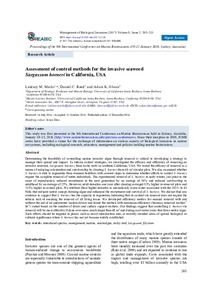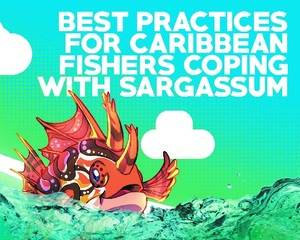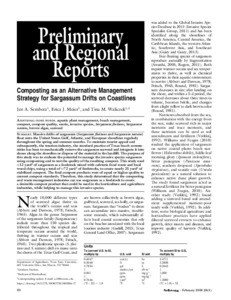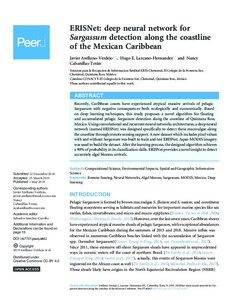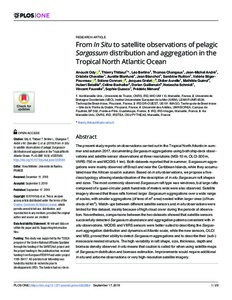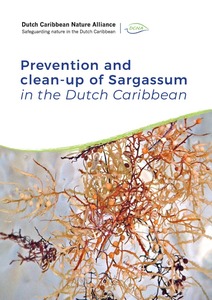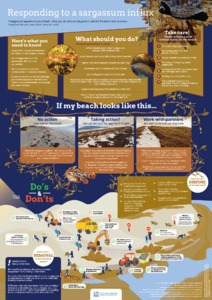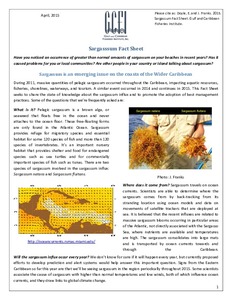Browsing ⇒ SARGASSUM Practices by Subject "Seaweed"
Now showing items 1-14 of 14
-
Assessment of control methods for the invasive seaweed Sargassum horneri in California, USA.
(2017)Determining the feasibility of controlling marine invasive algae through removal is critical to developing a strategy to manage their spread and impact. To inform control strategies, we investigated the efficacy and ... -
Best practices for Caribbean Fishers coping with Sargassum.
(Centre for Resource Management and Environmental Studies (CERMES), The University of the West Indies, Cave Hill Campus, Cave Hill, Barbados, 2019)What is Sargassum? -
Best Practices for Determining Volumetric Data of Fresh Sargassum Wracks.
(Texas A&M University Galveston Campus (TAMUG), Galvaston, TX, 2015)The purpose of this procedure is to identify the best practices for measuring and quantifying the size of Sargassum wracks, or piles of beached “seaweed” as it is often referred to, found along the coastlines surrounding ... -
Composting as an Alternative Management Strategy for Sargassum Drifts on Coastlines.
(2018)Massive drifts of sargassum (Sargassum fluitans and Sargassum natans) float onto the United States Gulf, Atlantic, and European shorelines regularly throughout the spring and summer months. To maintain tourist appeal and ... -
ERISNet: deep neural network for Sargassum detection along the coastline of the Mexican Caribbean.
(2019)Recently, Caribbean coasts have experienced atypical massive arrivals of pelagic Sargassum with negative consequences both ecologically and economically. Based on deep learning techniques, this study proposes a novel ... -
From In Situ to satellite observations of pelagic Sargassum distribution and aggregation in the Tropical North Atlantic Ocean.
(2019)The present study reports on observations carried out in the Tropical North Atlantic in summer and autumn 2017, documenting Sargassum aggregations using both ship-deck observations and satellite sensor observations at ... -
Golden Tides: Management Best Practices for Influxes of Sargassum in the Caribbean with a Focus on Clean-up.
(Centre for Resource Management and Environmental Studies (CERMES), The University of the West Indies, Cave Hill Campus, Barbados, 2016)The purpose of this management brief is to enable government officials, coastal managers, beach caretakers and coastal residents to get ahead of the “golden tides” by providing up-to-date information on the recent ... -
Golden Tides: Problem or Golden Opportunity? The Valorisation of Sargassum from Beach Inundations.
(2016)In recent years there have been massive inundations of pelagic Sargassum, known as golden tides, on the beaches of the Caribbean, Gulf of Mexico, andWest Africa, causing considerable damage to the local economy and ... -
Prevention and clean-up of Sargassum in the Dutch Caribbean.
(Dutch Caribbean Nature Alliance, Bonaire, Dutch Caribbean, 2019)In 2011, the shores of several Caribbean islands and West African countries were inundated by unprecedented quantities of pelagic sargassum. Since then, influxes of this golden-brown seaweed have become a recurrent event ... -
Responding to a sargassum influx. [poster]
(Gulf and Caribbean Fisheries Institute., Marathon, FL, 2018)If sargassum appears on your beach, what you do next can be good or bad for the beach and business. Important lessons have been learned. -
Sargassum Fact Sheet.
(Gulf and Caribbean Fisheries Institute., Marathon, FL, 2015)During 2011, massive quantities of pelagic sargassum occurred throughout the Caribbean, impacting aquatic resources, fisheries, shorelines, waterways, and tourism. A similar event occurred in 2014 and continues in 2015. ... -
Sargassum: a Resource Guide for the Caribbean.
(Caribbean Alliance for Sustainable Tourism (CAST) and Caribbean Hotel and Tourism Association, Coral Gables, FL, 2015)The Guide is intended to serveas an initial resourcefor the Caribbean, in particular to inform the tourism industry, local governments, environmental groups and residents about Sargassum seaweed, its impact and ... -
Slow Pyrolysis as a Method for the Destruction of Japanese Wireweed, Sargassum muticum.
(2015)Japanese wireweed, Sargassum muticum is an invasive species to Great Britain, which might be controlled by harvesting it for energy and chemicals. Pyrolysis is the thermal decomposition of the organic components of dry ... -
Strategic Sargassum Preparedness Plan.
(Fisheries Division, Ministry of Agriculture, Food and Fisheries,Commonwealth of Dominic, Commonwealth of Dominica, 2019)The objective of the Sargassum Preparedness Plan is to address the impacts of sargassum while capitalizing from its opportunities. To thoroughly understand the current research on sargassum and how the influxes ...
 Repository of community practices in Ocean Research, Applications and Data/Information Management
Repository of community practices in Ocean Research, Applications and Data/Information Management
